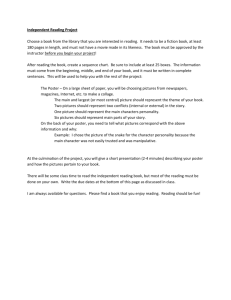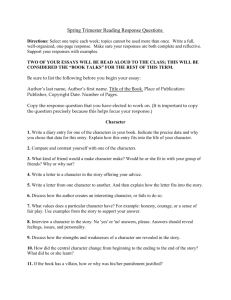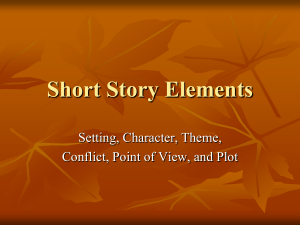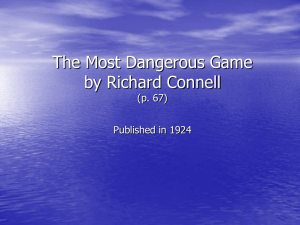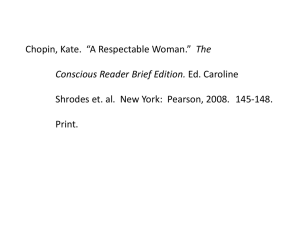Activity-based learning
advertisement
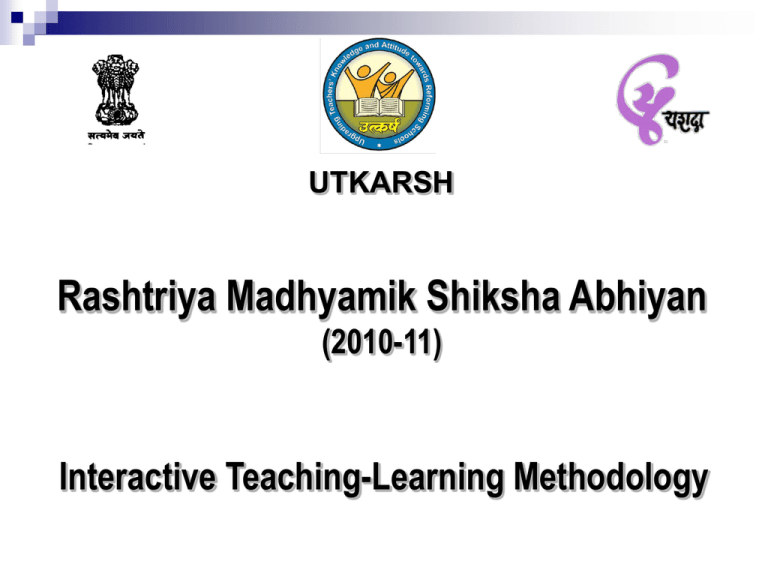
UTKARSH Rashtriya Madhyamik Shiksha Abhiyan (2010-11) Interactive Teaching-Learning Methodology Activity-based Learning – An Interactive Method What is activity-based learning? A constructivist learning approach A hands –on, creative, participative method of learning An interactive method in language learning •Learning should be constructive and self motivated •It should engage students actively for children are naturally curious and likes to explore their environment •Teacher should create an environment that is conducive for gaining knowledge Features and Advantages Learning happens through activities Learning becomes fun, an enjoyable process Learning is contextual, so, easy to grasp and meaningful Classroom activities are more studentcentric •Application of knowledge is more important than acquiring knowledge •Knowledge is applied through various activities in this method of learning •Activities bring variety to the process of learning. Contrast this with traditional passive listening •It's easier to catch and sustain the attention and interest of the learners when they are actively involved. •The retention of knowledge thus gained is permanent. •Bringing subjects down to the level of students’ experience makes understanding easier •Inviting active participation helps students open up. •They can freely try out the concepts they have learned. Students are not confined to their seats and classrooms Free exchange of ideas Children are self- motivated to know, to learn Teacher as a facilitator or guide, not an authoritarian •Students have freedom to move around. No student likes to be tied down to his bench. •Class rooms become a lively, interesting place. •Through pair-work, group-work, whole class discussions students are exposed to a variety of view points and perspectives. •The guided discovery approach leads students to a clearer understanding of the forms and underlying concepts (in grammar) •The teacher’s role is to set tasks that help students arrive at an understanding of the concepts, •make learning challenging and motivating by selecting appropriate material, •decide teaching tools, design activities, prompt and ask questions that make learning challenging and motivating. Most effective method for teaching language skills and thinking skills •Interactive teaching provides ample practice in speaking and listening skills. •Interacting with a group with similar skill helps remove inhibition and •develops confidence and fluency in the use of language. •Collaboration and exchange of ideas enriches the learner’s mind. •Role plays, skits create natural situations to think and gain new perspectives Activities to develop various language skills •Teachers should device activities to suit the age group and skills of the learners. •There should be variety in activities. •Activities should not only help gather knowledge, but apply and evaluate knowledge. •Activities should be interesting, and thought provoking. •There should be individual, pair, group and whole class activities. Reading Activities A reading lesson typically has three parts: pre, while and post activities. These activities are meant to activate prior knowledge of the learners even before they start reading. The logic behind activating prior knowledge is to build upon what students already know about a topic as a lead-in to the main reading task. The more teachers activate students’ prior knowledge, the easier it will be for the students to retain new information from the main reading task. Pre reading activities Aim Activating and building background knowledge Familiarizing students with the theme and vocabulary Bring the theme down to the experiential level of students Activities For theme a questionnaire, one or two questions, a picture or a comic strip that would lead to a discussion on the theme. For vocabulary, puzzling out from the context, brainstorming, matching words with meanings or crossword puzzles While reading Activities Aim Arouse and sustain interest, Establish connections, predict what is to come, encourage creative thinking Activities Read the headline and guess the theme/plot Read the first paragraph and guess the setting, period how the story would proceed – discuss various possibilities Read further, stop, ask if a twist is expected in the plot, and what tells this. Gap filling, completion of tables/trees/flowcharts. Post reading Activities Aim Better understanding of the topic/plot Insight into characters, motives Interpretation, analysis of situation reactions Creative thinking Draw attention to writing style, language, how information is organized Activities Group discussions, whole class discussions Table completion, gap filling Inferences and illustration Summarizing, sequencing, suggesting/matching headings, sub-headings Speaking Activities Aim Remove inhibition, build confidence Continuous and fluent interaction in natural situations both informal and formal Exchange of ideas and higher thinking skill Activities Narration and description Brainstorming and pair/group/class discussions for idea generation Role plays and repetition for learning language structures Speeches, debates for fluency and confidence building exercise Constraints of activity-based teaching Time factor: Students can get carried away by activities. Teachers with the pressure of completing syllabus on time may find lecture method more convenient Large classes: Teachers cannot freely move and monitor all groups and cannot provide individual attention Passivity: Just as in traditional class rooms a few always actively participate when others remain passive listeners Digression: Students tend to move away from the topic under discussion



